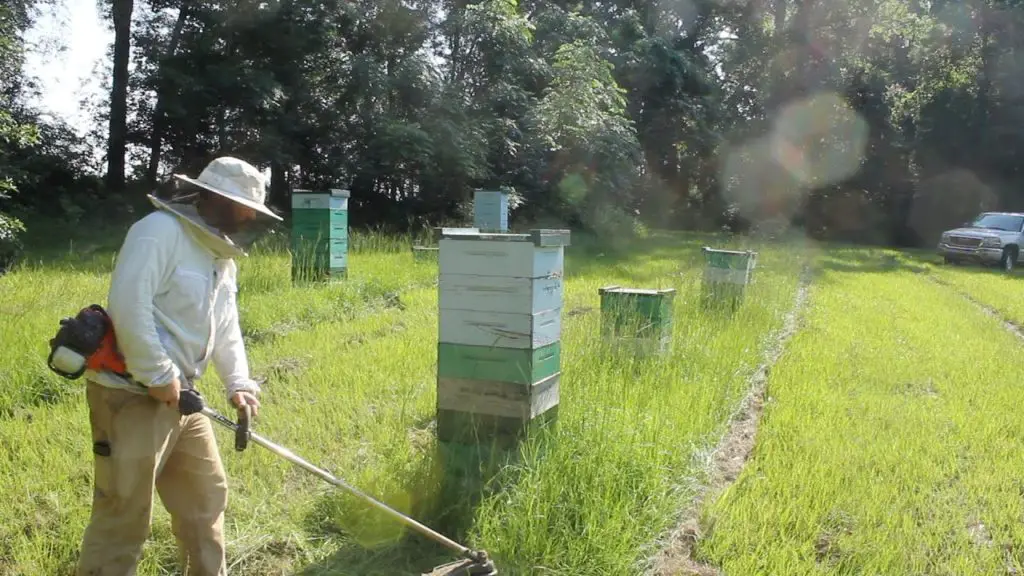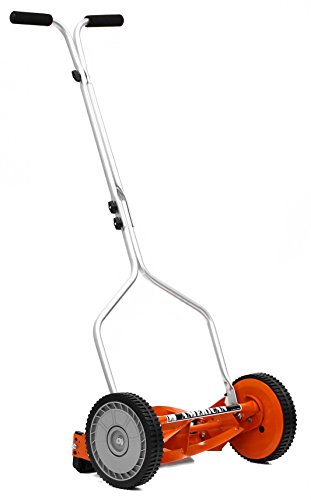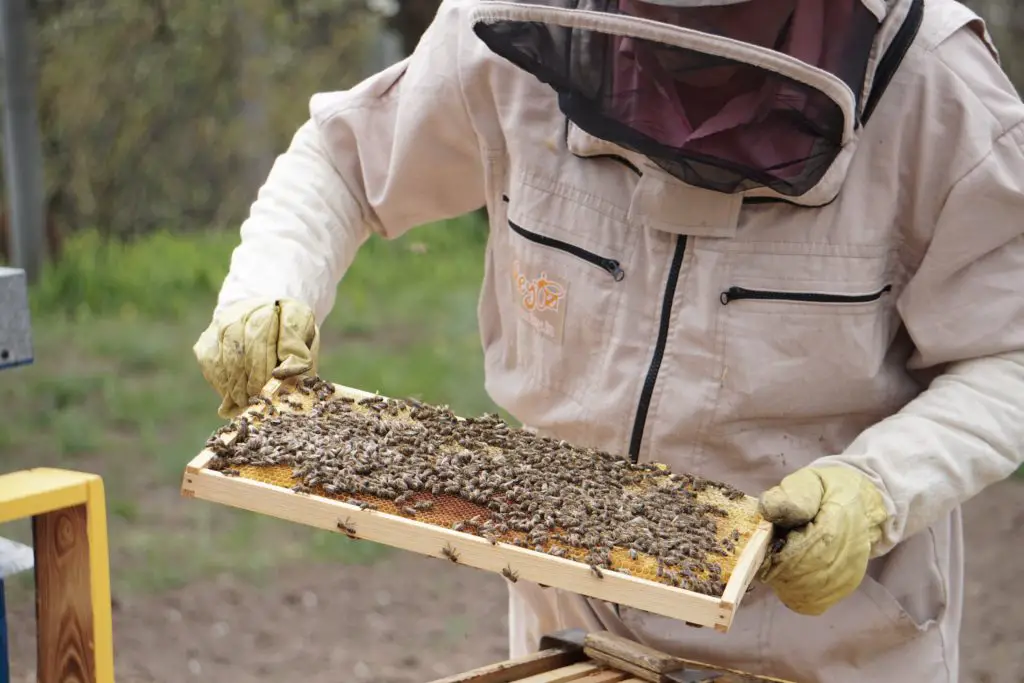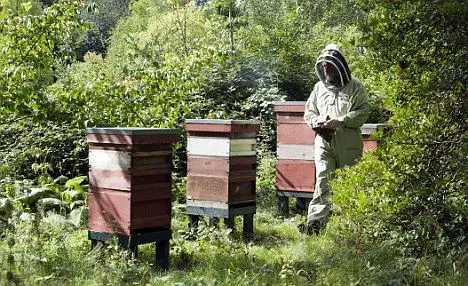Affiliate Disclaimer - As an Amazon Associate I earn from qualifying purchases.
It supports the website. So, Thank you
The last thing anyone wants for their bees is to upset them. These peaceful creatures might be disturbed by the noise and vibration from the lawn mower so a lot of beekeepers worry about mowing around the hive. However, you also don’t want to let the area become overgrown and unsightly. So, can you mow around the beehive?
Fortunately, most bees will show little to no reaction when you mow around the hive. That said, you have to be mindful and careful when mowing. Using minimal noise and mowing at the right time can help to reduce disruption to the hive.
As you can see, there’s no reason to leave the area around your beehive unmowed and in this guide, we will give you all the information you need to know to keep your bees happy while you maintain the grass.
Table of Contents
Is it Necessary To Mow Around The Hive?
It’s not essential to mow the grass around your beehive; the bees certainly aren’t going to care. In the wild, there isn’t a gardener with a mower keeping up appearances around the hive so a natural environment is probably best for the bees.
However, for us humans, mowing has a few benefits. For starters, most of us like to maintain a pleasant aesthetic in the yard and mowing the grass is just one way to do this. If you have placed your hives somewhere that can be easily seen, you don’t want to ruin the appearance with long, out-of-control grass.
What’s more, when it comes to collecting honey and taking care of the hive, long grass is just going to get in the way. A lot of beekeepers harvest their honey first thing in the morning when there will be dew on the grass. While this won’t hurt you, it’s pretty unpleasant having to wade through wet grass when you could just mow it.
It all comes down to personal choice. If you don’t mind the ‘wild’ look, then you might leave the grass around the hives to grow. If you prefer to mow then we have some great…
Tips For Safe Mowing Around The Beehive
The most important thing when mowing around your beehives is to make sure that the bees are happy. You don’t want to stress them out but also, when bees are upset, there is a risk of swarming and even the most experienced beekeeper won’t want to be caught up in that kind of bee storm!
Planning Is Essential
It’s no good pulling the lawn mower out of the shed and haphazardly getting to work. If you want the best outcome then planning is super important. This can be said any time you’re mowing the lawn but when bees are involved, we can’t stress the importance enough.
Spending as little time as possible around the hives is what you’re aiming to achieve and with careful planning this is easy.
You’ll want to make plans for the equipment you’re going to use as well as exactly where you will mow. Figure out which route you will take around the hive and whether there are any obstacles that you’ll need to consider. The last thing you want to do is stop while the mower is still running to remove an obstacle as this could upset the bees and cause them to swarm.
Choose The Right Type Of Mower
The best type of lawn mower for mowing around a beehive is a manual mower. These are sometimes called reel mowers and they make very little noise as they’re not powered. There is something of a stigma attached to these mowers in that people think they are incredibly difficult to operate.
If you think back to before the dawn of powered mowers and imagine your grandad pushing around a reel mower, huffing, puffing and probably swearing then it’s easy to see why they have this reputation. However, modern reel mowers are a lot easier to use.
Yes, they’re still more demanding in terms of labor than an electric or gas mower but as long as you’re relatively fit, you shouldn’t have any issues. This is especially true when you consider that you’ll only have to use the manual mower around the hive; you can use your regular mower for the rest of the yard.
If you really don’t want to or can’t use a push reel mower then we would urge you to opt for electric over gas-powered mowers. While both are noisy, an electric mower is typically a lot quieter and will give off fear vibrations. Moreover, gas mowers give off fumes which can upset the bees, not to mention, that they’re not good for the environment.

Suitable Lawn Mowers:
Or Use A Trimmer
Another tool you could use is an electric trimmer just to get those long bits of grass around the hive. Again, these create less noise and vibrations than gas models and you have the benefit of being able to cut at an angle, allowing better access to grass that’s growing close to the hive. Ultimately, it’s probably a lot quicker.
When you use a lawn mower, you may struggle to get right to the edge which means you’ll have to spend more time and you still won’t get the best results.
Mind The Clippings
Bees are not going to like it if a lot of grass clippings go flying into the hive; and who can blame them? I know I wouldn’t want to be disturbed like this when I was sitting at home minding my own business.
This is another reason that using a weed eater is a good choice since you have more control over where the clippings go.
If you are going to use a lawn mower then you’ll need to make sure it has a low deck and you use a grass collection bag. Never mow around the hive using the mulching function or a rear or side discharge chute. This will send clippings flying into the hive and that’s not a situation the bees are going to thank you for.
Don’t Use Chemicals To Treat The Lawn
It probably doesn’t take us to tell you that bees aren’t going to benefit from chemicals you might use on the lawn. These might be weed killers, fertilizers or chemicals to treat disease. They’ll work wonders for your grass but they’ll do the bees no favors.
If you need to treat the lawn then there are natural solutions you can make which won’t cause any upset to the hive. Using diluted vinegar is a great option for spraying on weeds and you might also use this to kill off the grass around the hive to save you from mowing there.
Wear A Bee Suit
As a beekeeper, we’d like to assume that you own a bee suit, sometimes called a bee smock. These protective suits are not only ideal when you’re tending to the hive but they’re also great when you have to mow around the edges.
A bee suit will offer protection to the torso, neck and head in the event that the bees get upset and start to string or swarm.
In addition to a bee suit, you may also wish to don a pair of gloves and protective pants. Wearing a sturdy pair of boots that completely cover your feet is also essential.
Consider When You’ll Mow Around The Hive
The tips above will help to keep the bees happy and you as safe as possible when mowing around the hive. However, there are some other things you’ll want to consider such as when you’re going to mow.
A lot of people choose to mow at times of the day when the bees are least active. This includes first thing in the morning and during the evening. If you are going to mow in the evening, it may be possible to cover the holes in the hive to keep the bees in until the following morning. Just don’t forget to remove the covers so the bees can get out.
However, there are some people that prefer to mow around the middle of the day as a lot of the bees will be out of the hive foraging at this time.
But regardless of what time of day you choose to mow, you will need to be mindful of the fact that bees become more defensive and aggressive at certain times of the year. For example, they’re likely to be a bit more feisty in the late summer through into early fall. If you can avoid mowing at these times then it’s going to be much better for everyone involved.
A Note On Weather
Bees are more active on warm, sunny days and it’s unlikely you’ll see much activity when it’s overcast or wet. While you might think that this is the best time to mow around the beehive, wet grass isn’t good for your lawn mower and even if you do manage to mow, the blades will simply tear wet grass, ruining its health and quality.
Avoiding Mowing Altogether
As we mentioned earlier, there’s no real need to mow around the hive, if you’re going to do this, it’s going to be for your own benefit.
But most of us would admit that we don’t want unsightly overgrown grass around the hive so how about not having grass at all?
You could replace the lawn around the hive with other materials. You might lay pavers, gravel or create a flower bed; the bees will love that too!
Just make sure that you use some sort of weed barrier cloth underneath your chosen material so that weeds cannot get through.
Conclusion
If you want the best for your bees then you won’t want to disturb them when maintaining your yard. However, with a need to get rid of long grass, you’re going to need to mow and this requires you to learn how to cut the grass around beehives.
You’ll need to make sure that you are careful when mowing and don’t do anything to upset the bees. Using quiet tools and getting in and out quickly can help but we’d also recommend protecting yourself by wearing a bee suit.













